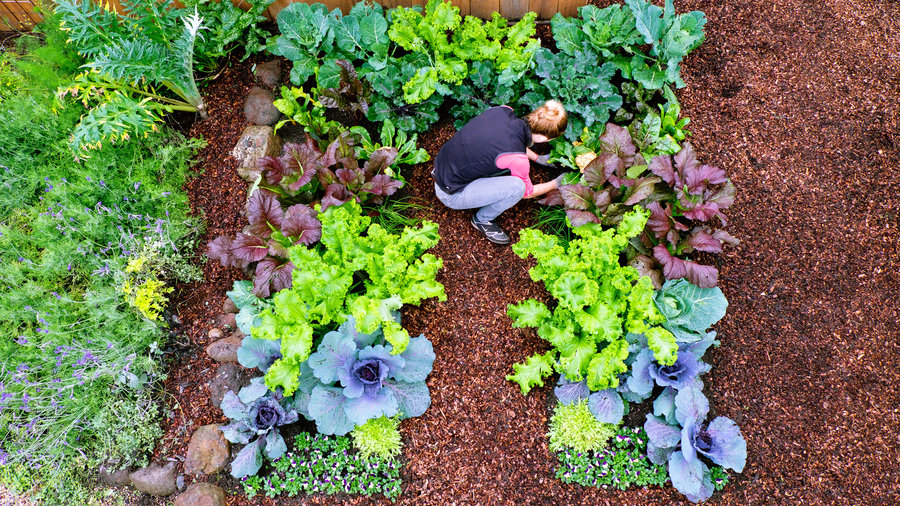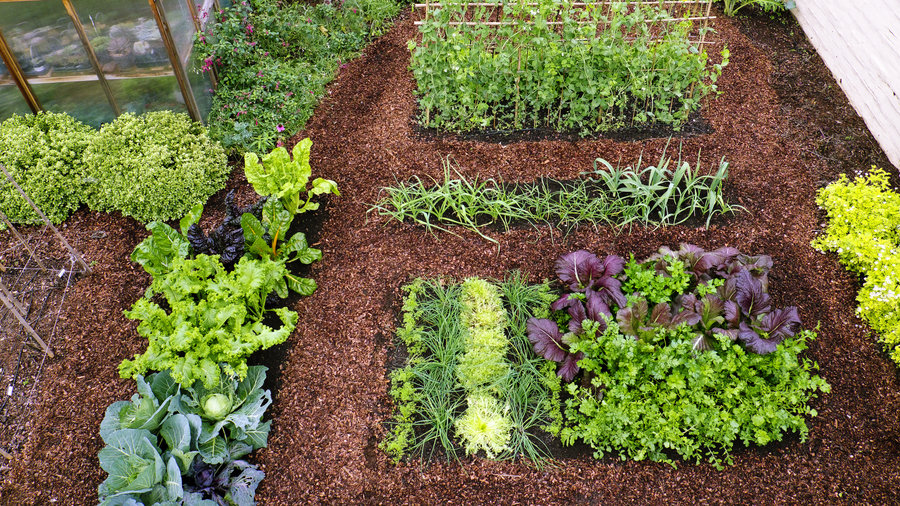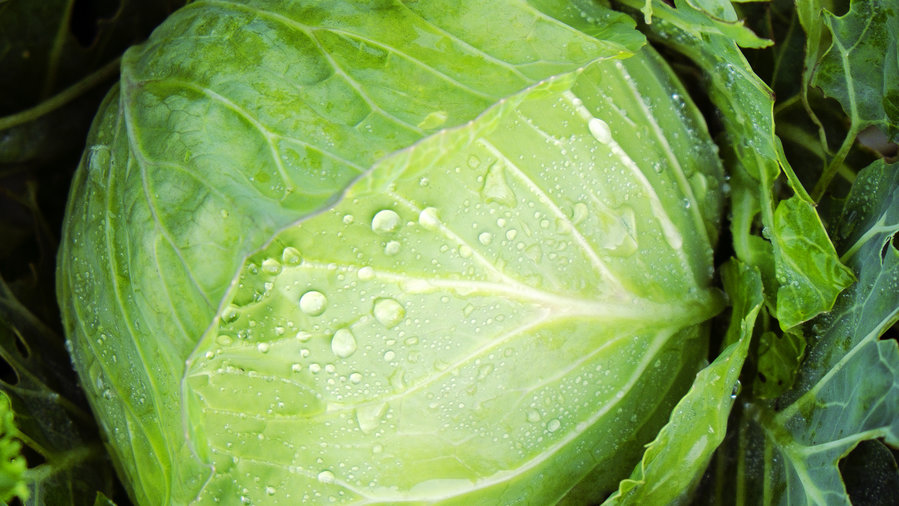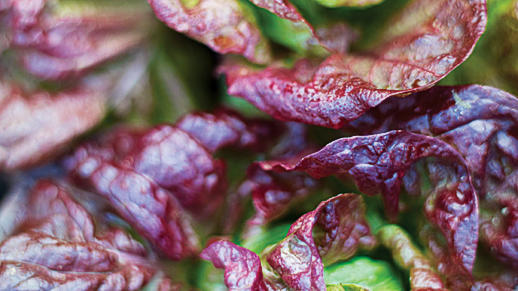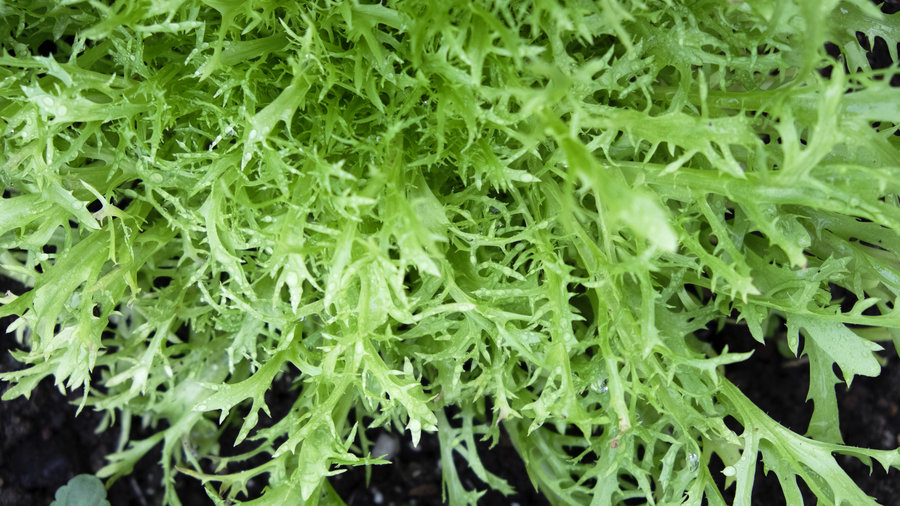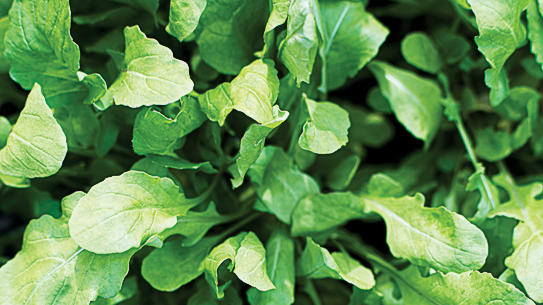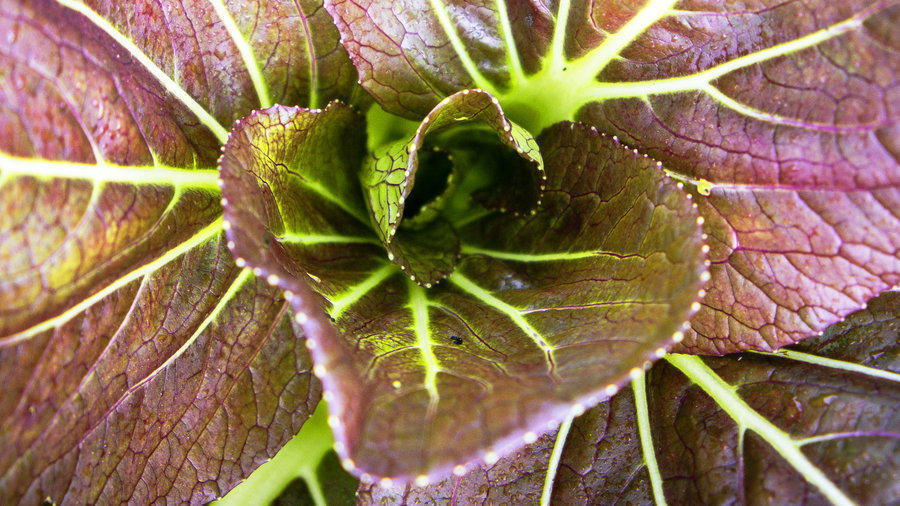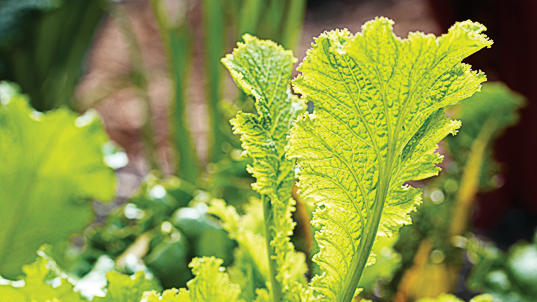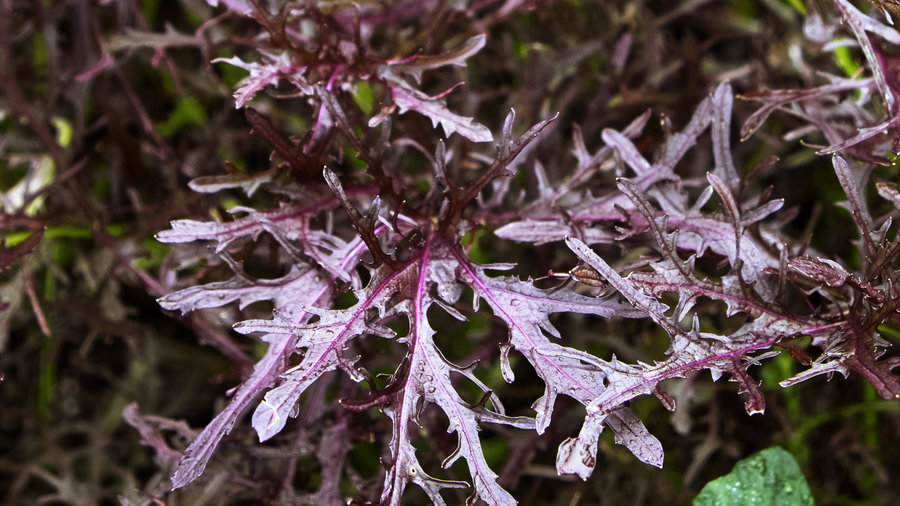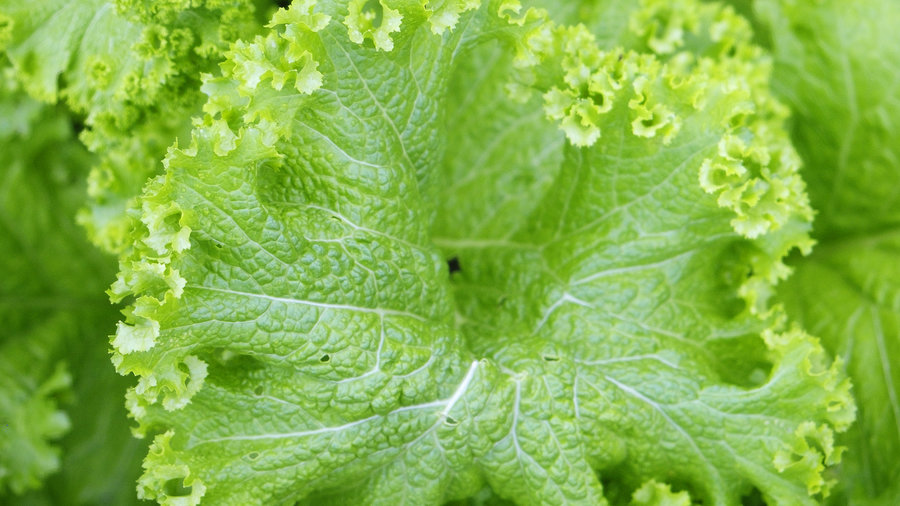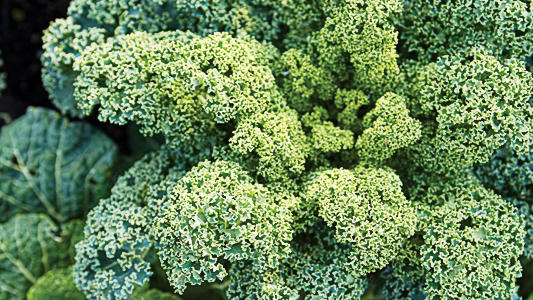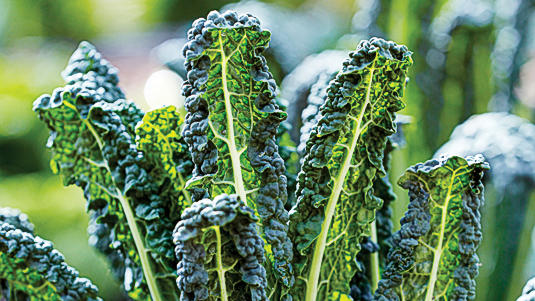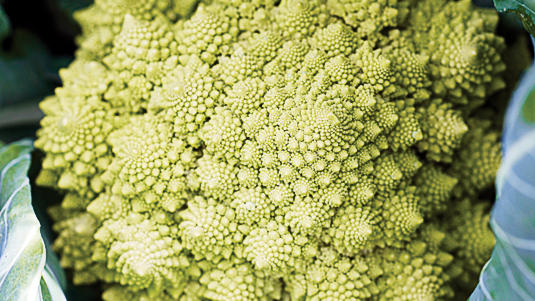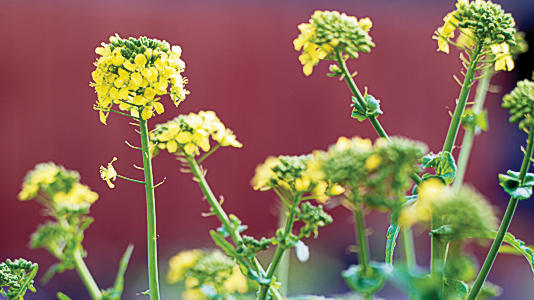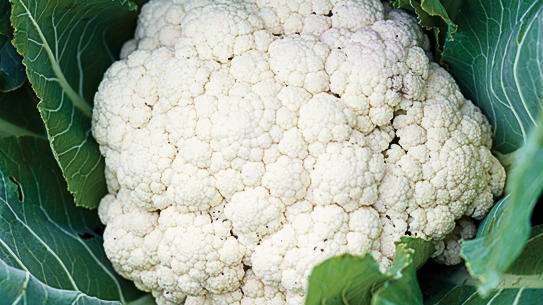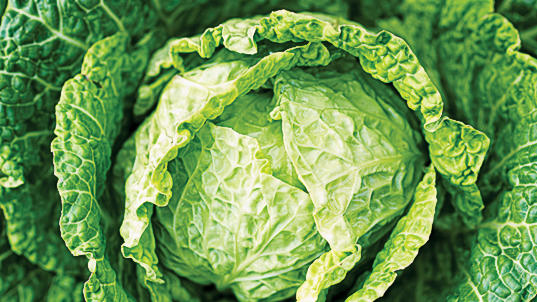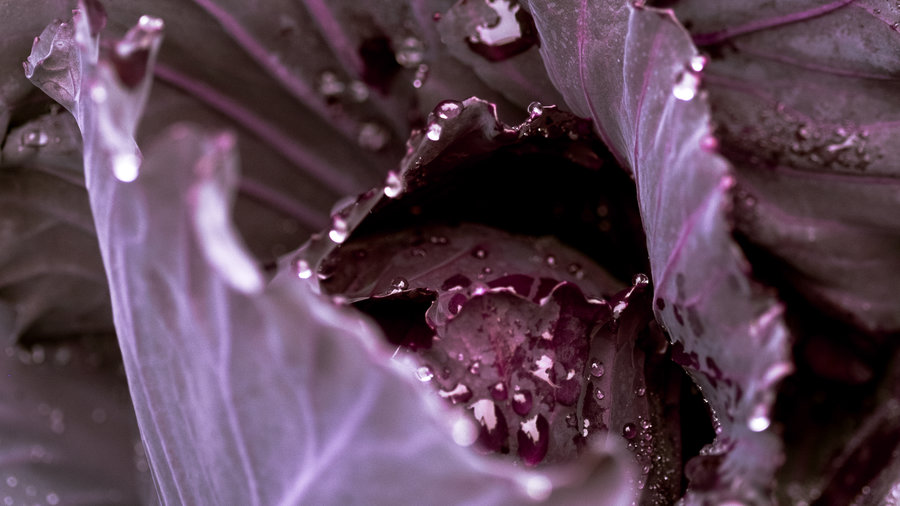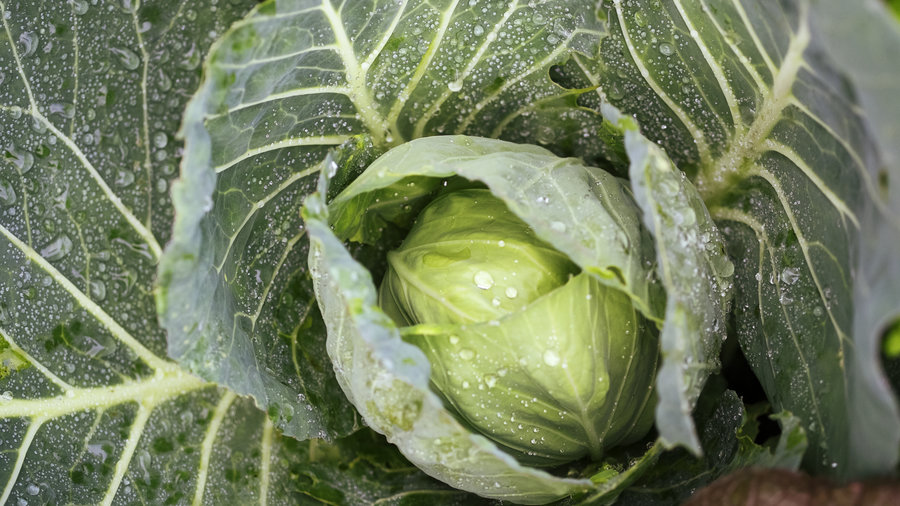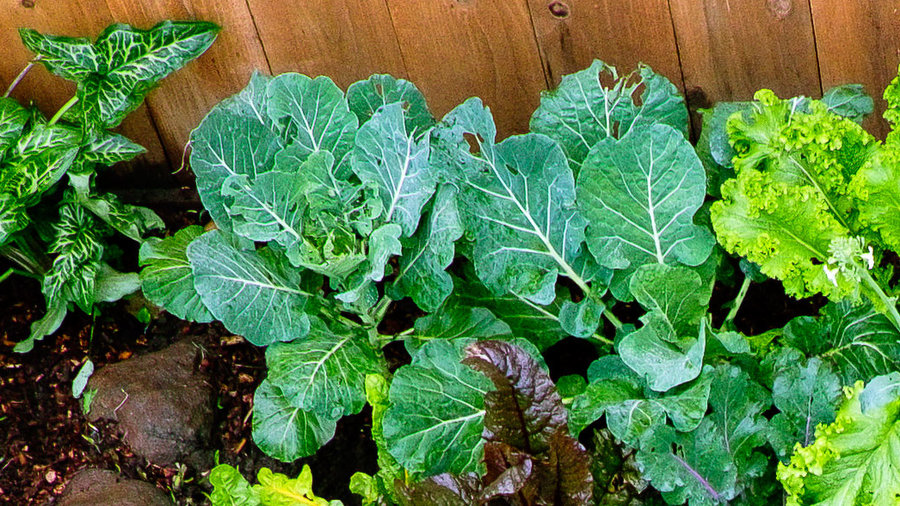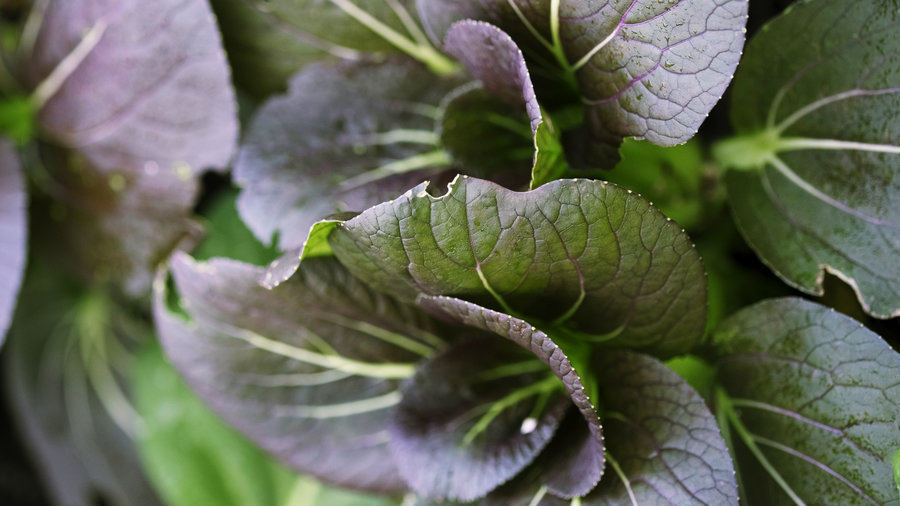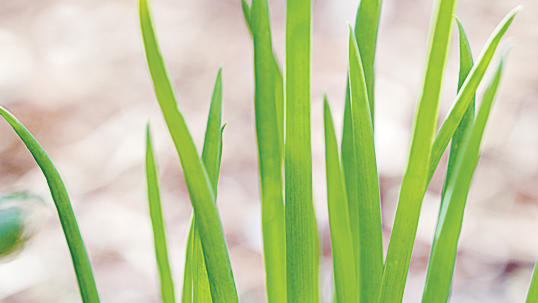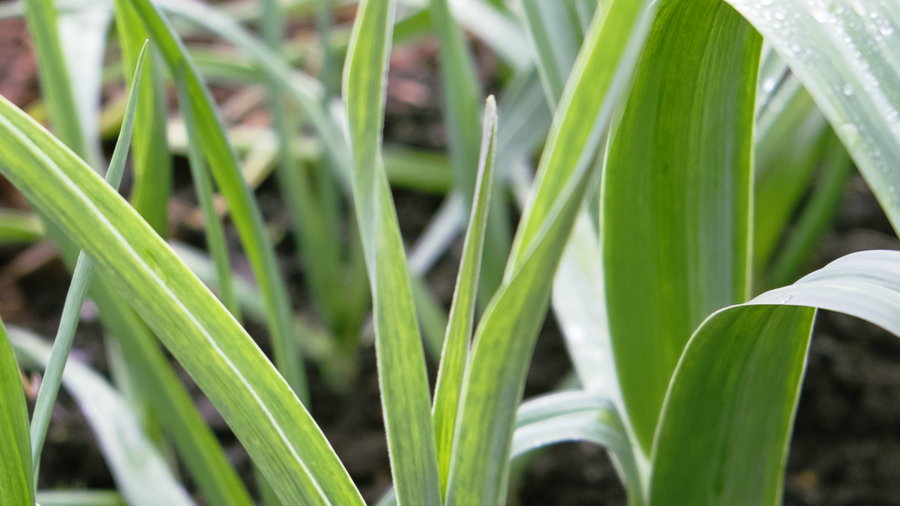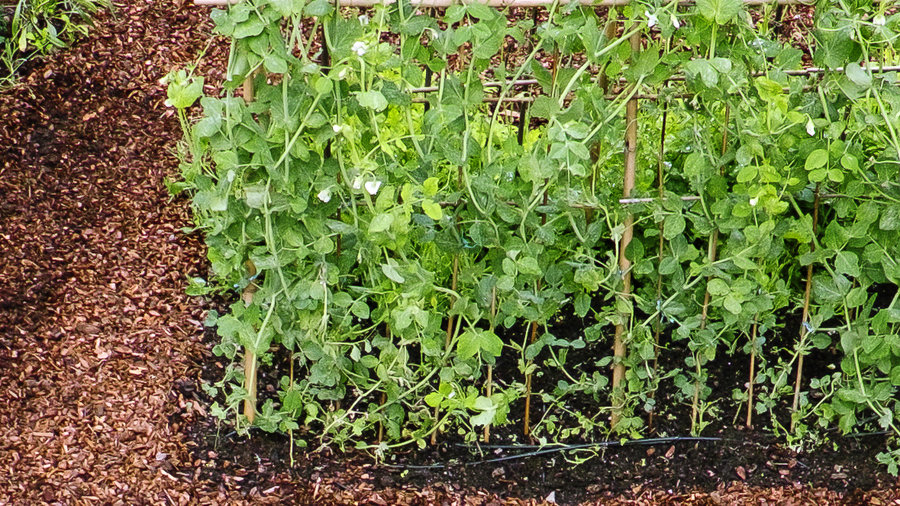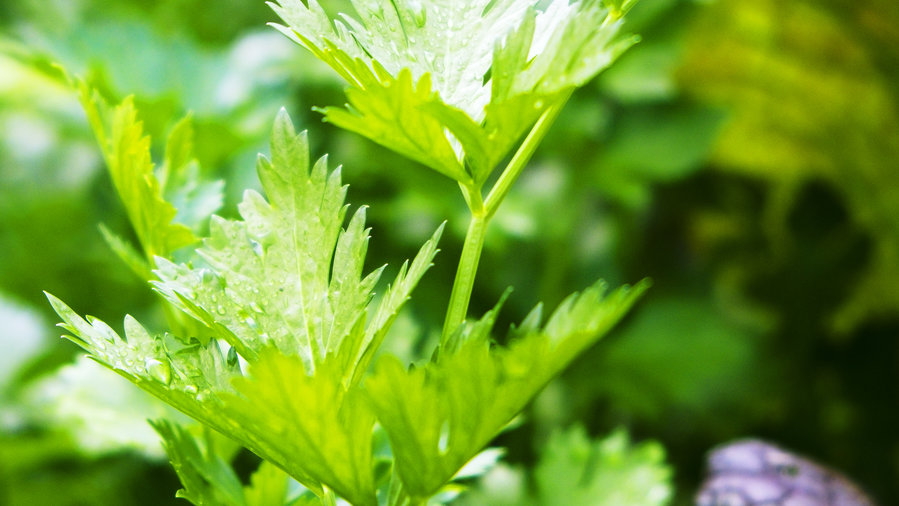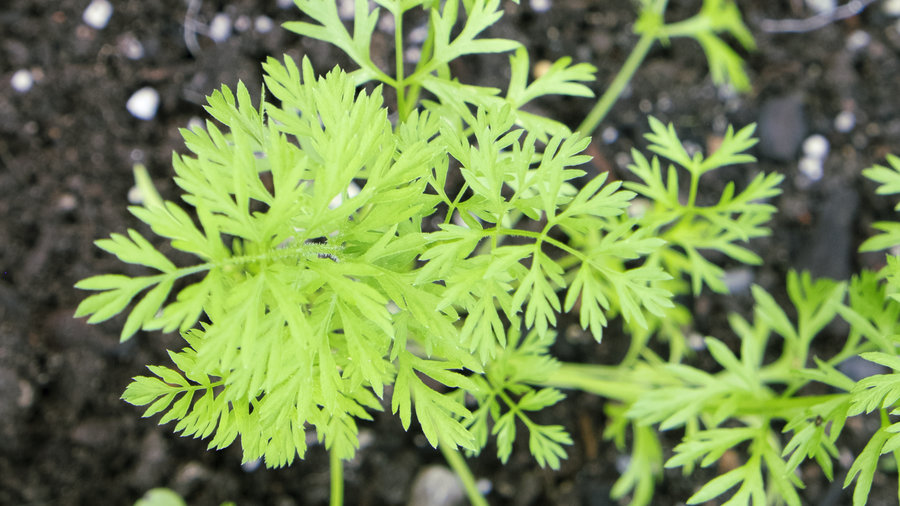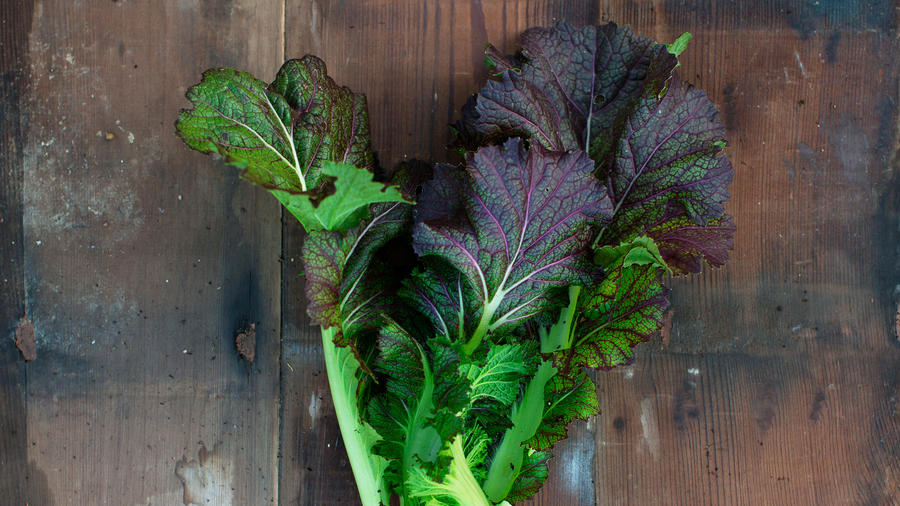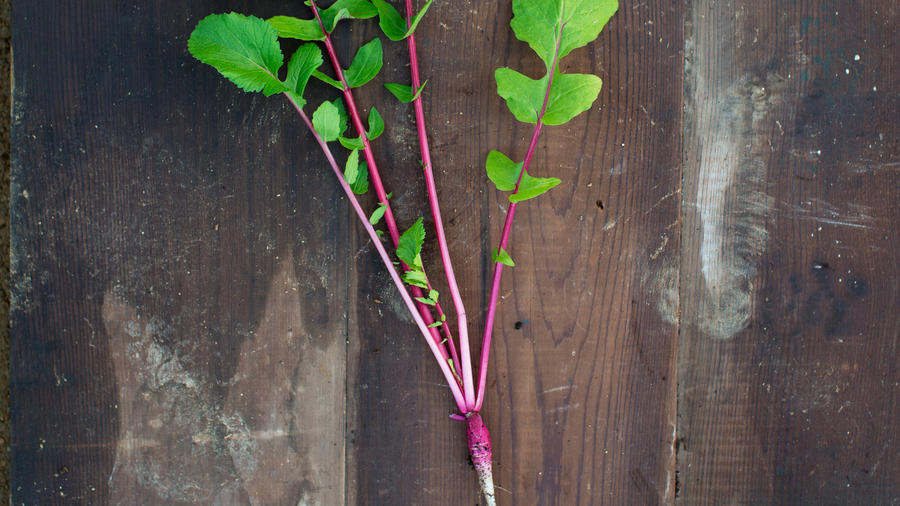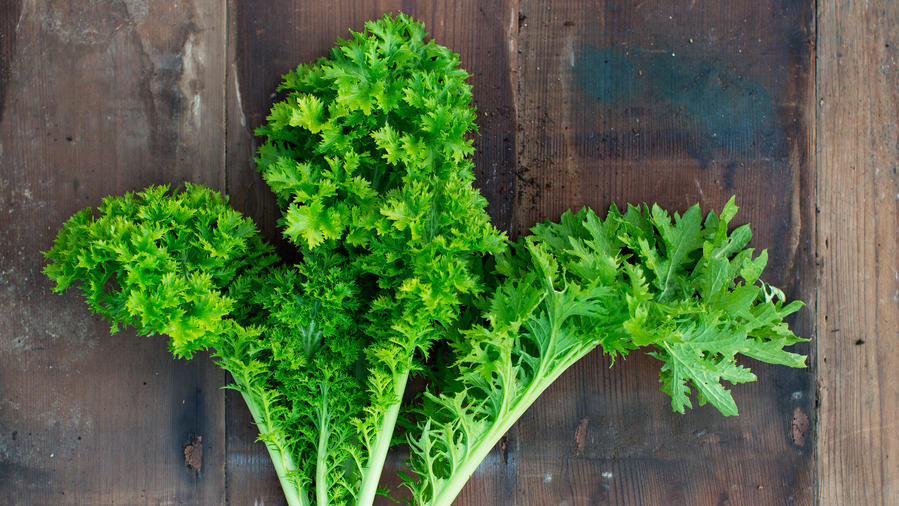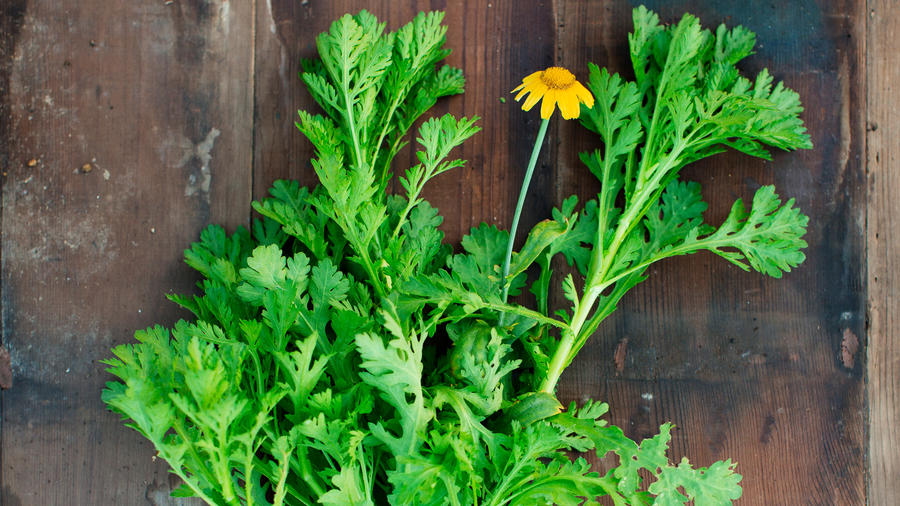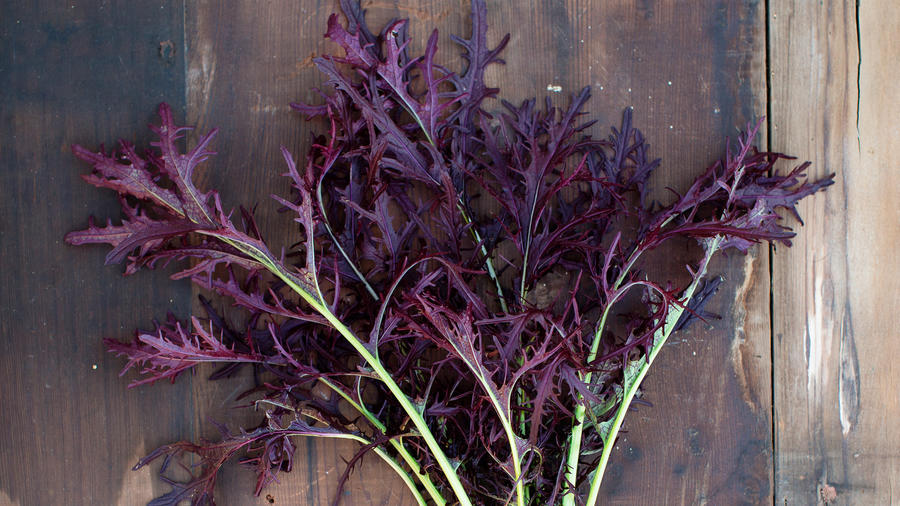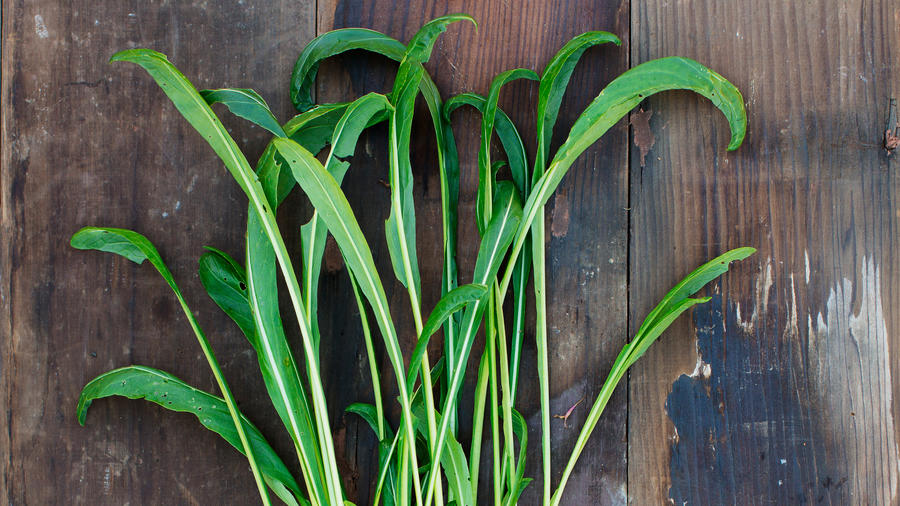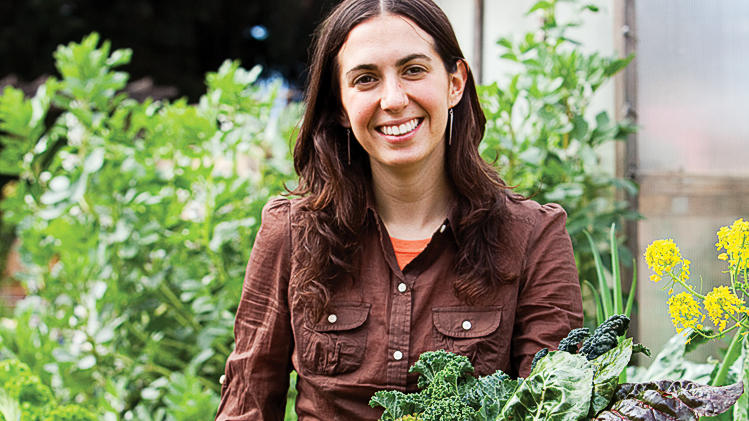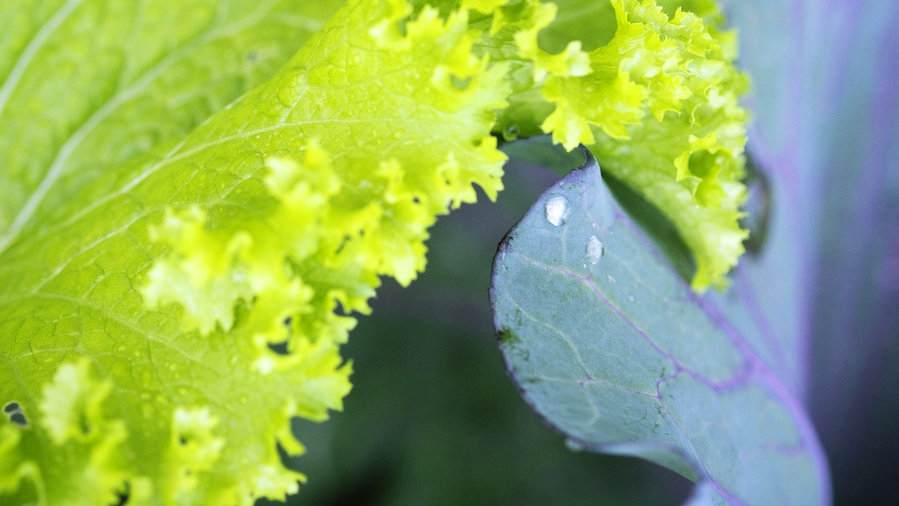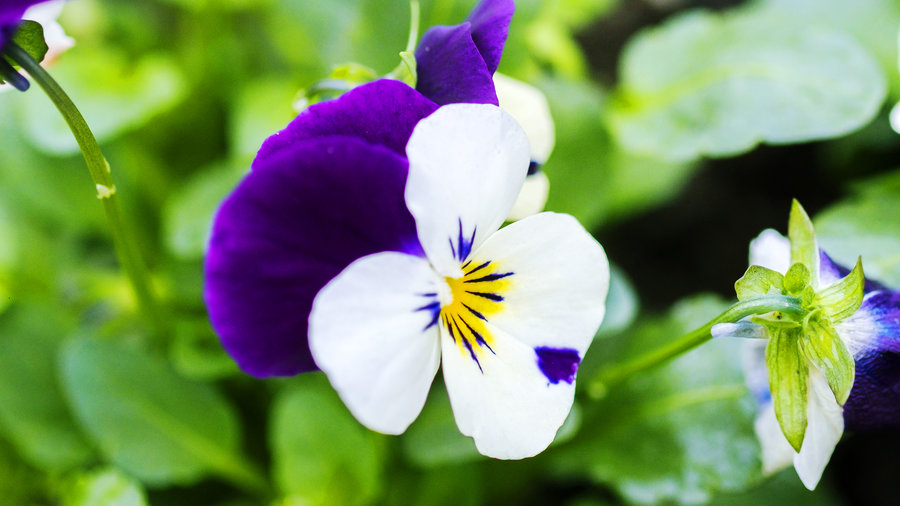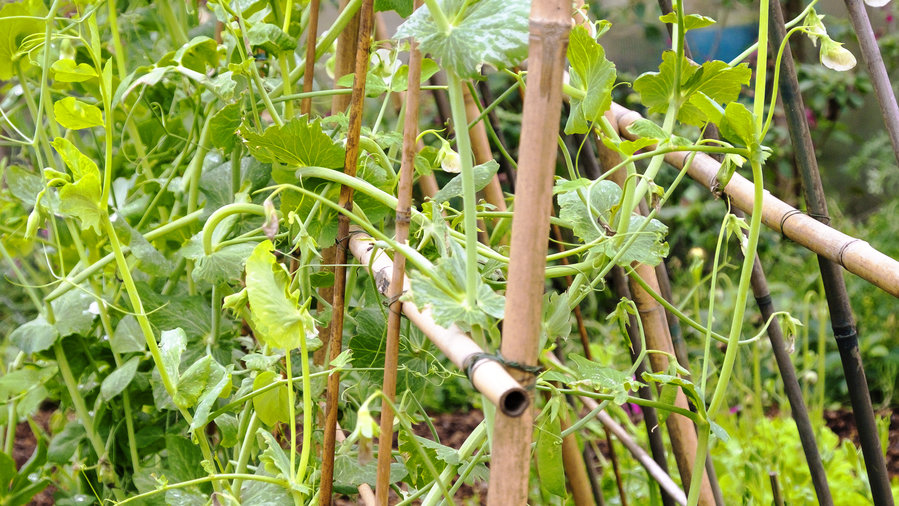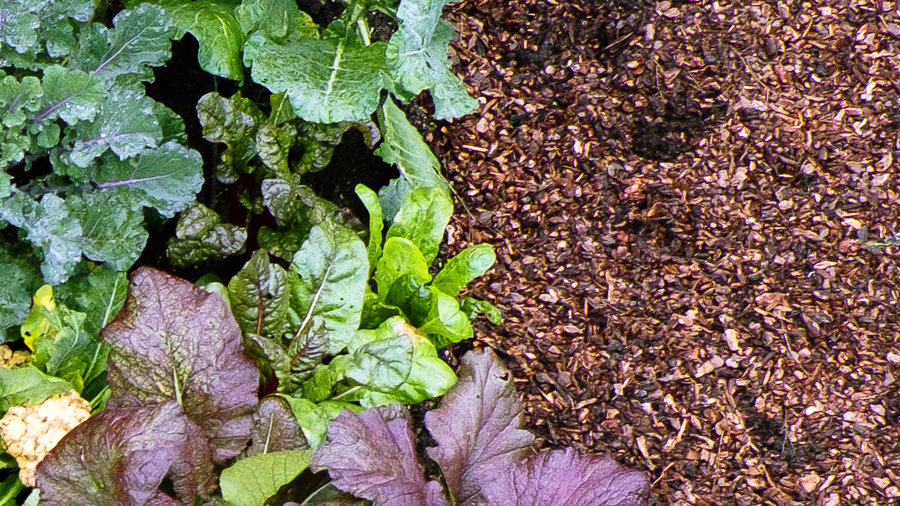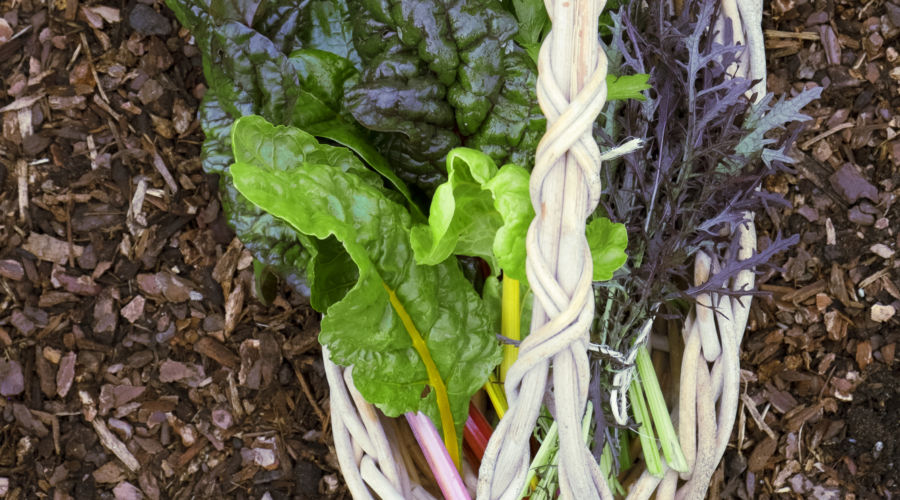Thomas J. Story
Keyhole garden layout
A keyhole design makes the most of a smaller yard because it gives over minimal real estate to pathways. Make beds no wider than 4 feet for easy maintenance and harvest; keep soil loose and healthy by walking on pathways only. In this Test Garden plot, we created symmetrical plantings for a flow of colors and textures. The beds measure 2 1⁄2 feet wide and 9 feet long, connecting at one end, and feature (clockwise):
- Collard ‘Top Bunch’
- Mustard ‘Southern Giant’
- Collard ‘Georgia’
- Brokali (broccoli/kale hybrid)
- Swiss chard ‘Bright Lights’
- Mustard ‘Red Giant’
- Cabbage ‘Stonehead’
- Mustard ‘Southern Giant’
- Cabbage ‘Red Jewel’
- Frisée
- Viola ‘Sorbet Coconut Swirl’
Thomas J. Story
Rows garden layout
In a larger yard, simple rows have graphic impact (think of striped farmland). Make beds no wider than 4 feet for easy maintenance and harvest; keep soil loose and healthy by walking on pathways only. In an area measuring 15 by 18 feet, we kept beds graphic by planting bands of a single vegetable variety, then created a backdrop with tall vining crops. The four rows are 7 feet long, of varying widths, and include (clockwise):
- Cabbage ‘Red Jewel’
- Cabbage ‘Stonehead’
- Mustard ‘Southern Giant’
- Swiss chard ‘Bright Lights’
- Sugar snap peas ‘Super Sugar’
- Siberian garlic
- Garlic ‘Early Italian Red’
- Elephant garlic
- Italian parsley
- Mustard ‘Red Giant’
- Cutting celery
- Arugula
- Chives
- Frisée
- Carrot ‘Rainbow Sun’
Thomas J. Story
Veggie gardens to fall for
As much as we love ripe tomatoes, by midsummer, we’re already fantasizing about our fall vegetable garden. While rangy tomato vines and dead cornstalks make their way to the compost pile this time of year, we replant our Test Garden beds with the prettiest edibles: structural Swiss chard, voluptuous cabbage plants, and vining snap peas. By getting the garden established in the still-warm fall days and watered by rainfall, a cool-season garden looks good from autumn through spring. Click ahead for tips from our vegetable plots, from design advice to the best vegetables to plant for the cool season.
Thomas J. Story
Lettuce
‘Marvel of Four Seasons’, a heading heirloom variety, has sweet-tasting, wavy bronze-tipped leaves. It’s a great addition to a fall or winter vegetable garden because it can be direct-sown from seed in late summer and grows fast enough to harvest before it freezes.
Thomas J. Story
Frisée
This Mediterranean green (also called curly endive) is prized for the spice and texture it brings to fresh salads. Frisée and other endives (like escarole) tolerate more heat than lettuces but grow faster in cool weather, typically maturing in 90-95 days after sowing seeds.
Thomas J. Story
Arugula (Italian)
Arugula is one of our favorite greens for the fall and winter garden.Growing winter greens has never been easier than sprinkling arugula seed — it will self-sow in the spring.
Tender leaves add bite to salads and other dishes. For best flavor, harvest them when they’re 4 inches tall.
Thomas J. Story
Swiss chard
The sturdy stalks of ‘Bright Lights’ come in a rainbow of colors, including gold, pink, red, and white; the frilly leaves are dark green.
Thomas J. Story
Red Giant mustard
Sometimes growing winter greens actually means growing reds; this winter vegetable is pretty enough to grow as an ornamental. ‘Red Giant’ forms stunning maroon leaves with bright green ribs. Spicier than store-bought mustard varieties, it makes an excellent addition to salads paired with robust poultry and meat dishes. Light frost deepens the flavor and color.
Thomas J. Story
Southern Giant mustard
Bright lime ‘Green Wave’ has frilly leaves and won’t bolt (rush to seed) as fast as other mustards when weather warms. Here are some great ways to use this variety in your cooking:
- Chop greens and simmer in chicken stock with slices of ginger and bean-thread noodles
- Sprinkle chopped greens into risotto
- Mix greens into rice dressing for roasted turkey or chicken
Thomas J. Story
Ruby Streaks mustard
Sweet and pungent. ‘Ruby Streaks’ mustard grows from a center stalk surrounded by a frill of finely serrated, ruby-colored leaves. Cool weather causes the color to deepen to deep purple while higher temperatures can prompt the plant to bolt (send up flower stalks). If allowed to flower, the edible blooms can be snipped for garnish for soups, salads, or open-faced sandwiches.
Thomas J. Story
Mustard ‘Green Wave’
Bright green leaves practically glow in a fall garden and is a gorgeous addition to a winter vegetable garden. The hot flavor mellows when cooked, and this variety is slow to bolt.
Thomas J. Story
Curly-leafed kale
Super-ruffled ‘Winterbor’ is a vigorous grower that stands up to cold temperatures. Leaves turn sweeter after frost.
Thomas J. Story
Lacinato kale
Bumpy gray-green leaves of ‘Nero di Toscana’ are tasty, ornamental, and extra hardy. This one is prone to aphid attacks during the warm season — just one more reason we prefer growing it as a winter green.
Great ways to use it:
- Blanch, then add to penne pasta along with cooked Italian sausage.
- Pan-fry in extra-virgin olive oil with preserved lemon and red chile flakes.
- Simmer until tender, chop, and layer into meat or vegetarian lasagna.
Thomas J. Story
Brokali ‘Apollo’
This broccoli/kale hybrid produces small broccoli heads and side shoots that keep growing large, tender leaves.
Thomas J. Story
Romanesco broccoli
This is a beautiful addition to any winter vegetable garden. The multipointed chartreuse heads of ‘Veronica’ have a texture and flavor similar to mild, nutty cauliflower, and look like a fractal.
Great ways to use it:
- Steam florets and toss while still warm with your favorite vinaigrette.
- Sauté florets in butter with oil-popped mustard seeds and cumin seeds.
- Roast florets with olive oil, olives, and halved shallots.
Thomas J. Story
Broccoli raab (Rapini)
When growing winter greens, sometimes it’s okay to let them bolt. Leaves and small florets of ‘Spring Raab’ have a slightly stronger flavor than broccoli.
Thomas J. Story
Cauliflower
‘Cassius’ has round, creamy white heads that reach 7 to 8 inches across, with a rich flavor.
Thomas J. Story
Savoy cabbage
Lime green ‘Alcosa’ forms tight heads, ideal for closely spaced planting. Growing winter greens this beautiful can be a purely aethetic decision.
Great ways to use it:
- Braise with olive oil, onions, bacon, and caraway seeds.
- Chop coarsely and pan-fry in butter with diced potatoes.
- Steam individual leaves until just tender, then use the leaves as wraps for steaming fish.
Thomas J. Story
Red Jewel cabbage
Stunning both in the garden and on the plate, ‘Red Jewel’ forms deep burgundy leaves in almost perfectly round heads. The mild flavor, crisp texture, and stunning color make it one of our favorites for cool-season edible gardens.
Thomas J. Story
Napa cabbage
With a mild flavor and crunchy texture, Napa cabbage makes a delicious addition to soups and salads. The heirloom ‘Flat Dutch’ variety (pictured) produces firm, large heads that store well. We love growing this winter green because the store-bought versions usually have the delicious outer green leaves stripped off.
Great ways to use it:
- Slice and sautéed with plenty of garlic and olive oil
- Add to hot soup broth and allow to soften before serving
- Thinly slice and eat raw dressed with sesame oil, rice wine vinegar, and slivered almonds
Thomas J. Story
Red bok choi
Similar to the all-green varieties in flavor, red bok choi (also called red bok choy or red pak choi) grows beautiful russet leaves which deepen in color in cool temperatures. Harvest outer leaves to add to salad mixes or cut the entire plant to stir fry.
Thomas J. Story
Green onion
Growing winter greens doesn’t always mean leafy crucifers! Both the white and green parts have a strong, zesty flavor.
Thomas J. Story
Elephant garlic
Closely related to leek, elephant garlic forms unusually large edible bulbs with a mild garlic flavor. Young leaves can also be snipped and used like scallions.
Thomas J. Story
Sugar snap peas
Grow tall peas with the support of trellising or choose a bush-variety that requires no support. ‘Super Sugar Snap’ (pictured) is a tall-growing variety that can be eaten either as a whole-pod when picked young or left on the vine and harvested for shelling the peas.
Thomas J. Story
Cutting celery
This leafy herb is more about an intense celery flavor than a crisp stalk, and is outstanding in Asian dishes like Phnom Penh noodle soup. Keep it on hand for adding to soup stock.
Thomas J. Story
Carrots
Start seeds for carrots in sandy soil completely free of rocks and clods. ‘Purple Sun’ produces deep purple carrots with a center sunburst of gold—particularly pretty sliced in salads.
Dragon's tongue mustard
Slow to bolt and easy on the eyes, plant in groups for splashes of deep purple color throughout the winter garden.
‘Saisai Purple’ radish
These rounded peppery leaves are tasty and lack the prickly texture of most radish tops. If you’re in it for the radish root, try an interesting variety like Noir Long Maraicher Black for fun.
Wasabi mustard
The name says it all—lime green with a nose-tingling kick. Pick young to eat as microgreens, or use larger leaves in stir-fries.
‘Oasis’ edible chrysanthemum
Versatile and delicious, young foliage adds crunch to salads and sandwiches, while dried yellow flowers make an aromatic tea.
‘Scarlet Frill’ mustard
A rarity at the market because it doesn’t store or travel well. Plant seeds in late summer and pick young leaves directly from the garden for a spicy addition to salads.
Early mibuna
Fast growing and cold-tolerant, these mustard-flavored greens are packed with vitamins and ideal for gardeners living in chillier climates. Growing winter greens like this unusual specimen can stimulate your creativity in the kitchen, too.
Thomas J. Story
Planting tips
Soil. Till the bed with a garden fork to remove rocks and break up clumps before raking the soil smooth. Then cover the soil with a few inches of compost, till that in, and rake again.
Planting. Start most of the seeds indoors in September―except arugula, which you can sow directly in the ground―then transplant seedlings outdoors six to eight weeks later. (In cold climates, plant in spring.) Always sow extra seeds in case some don’t germinate, and keep excess seedlings in case any plants in the ground fail.
Spacing. Though you can follow the recommendations on the seed packets, space seedlings on the tighter end of the range so the beds will look lush.
Thomas J. Story
Design tip: Plant for contrast
Remember, you can grow winter greens for ornamental purposes as well as utility. Place different shapes and colors next to one another. Here, frilly green leaves of chartreuse mustard pop against purple cabbage.
Thomas J. Story
Design tip: Mix in flowers
Include an edge of violas for cheer; the edible blossoms can dress up winter salads too.
Thomas J. Story
Design tip: Use support
Create a simple A-frame trellis out of bamboo and wire to support vining snap peas—and add a lush backdrop to beds.
Thomas J. Story
Design tip: Keep it bountiful
Plant crops that produce all season, like kale and chard. They maintain garden structure as you pull out single-harvest ones, like cabbage.
Thomas J. Story
Harvesting tips
The only thing easier than growing winter greens is harvesting them. Cut the outer leaves of cool-season greens—such as collards, kale, mustard greens, and Swiss chard—often to encourage new leaves to form. For head-forming crops such as cauliflower and cabbage, use pruners to cut off the heads when they’re firm and well-formed. When arugula reaches 4 to 6 inches tall, shear it down to 1 to 2 inches tall so it will regrow.
